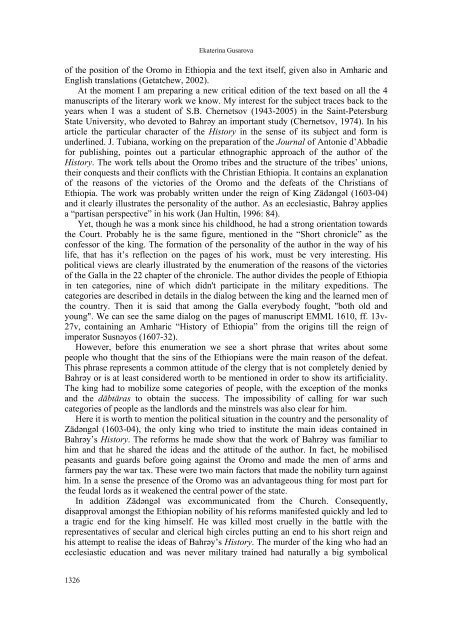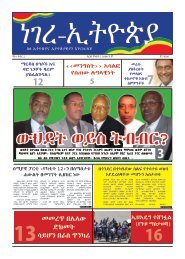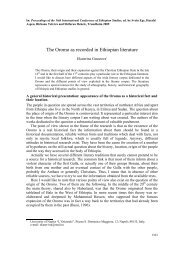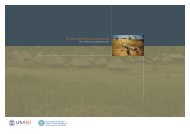Ekaterina Gusarova - The Oromo as recorded in Ethiopian literature
Ekaterina Gusarova - The Oromo as recorded in Ethiopian literature
Ekaterina Gusarova - The Oromo as recorded in Ethiopian literature
Create successful ePaper yourself
Turn your PDF publications into a flip-book with our unique Google optimized e-Paper software.
<strong>Ekater<strong>in</strong>a</strong> <strong>Gusarova</strong><br />
of the position of the <strong>Oromo</strong> <strong>in</strong> Ethiopia and the text itself, given also <strong>in</strong> Amharic and<br />
English translations (Getatchew, 2002).<br />
At the moment I am prepar<strong>in</strong>g a new critical edition of the text b<strong>as</strong>ed on all the 4<br />
manuscripts of the literary work we know. My <strong>in</strong>terest for the subject traces back to the<br />
years when I w<strong>as</strong> a student of S.B. Chernetsov (1943-2005) <strong>in</strong> the Sa<strong>in</strong>t-Petersburg<br />
State University, who devoted to Bahrəy an important study (Chernetsov, 1974). In his<br />
article the particular character of the History <strong>in</strong> the sense of its subject and form is<br />
underl<strong>in</strong>ed. J. Tubiana, work<strong>in</strong>g on the preparation of the Journal of Antonie d’Abbadie<br />
for publish<strong>in</strong>g, po<strong>in</strong>tes out a particular ethnographic approach of the author of the<br />
History. <strong>The</strong> work tells about the <strong>Oromo</strong> tribes and the structure of the tribes’ unions,<br />
their conquests and their conflicts with the Christian Ethiopia. It conta<strong>in</strong>s an explanation<br />
of the re<strong>as</strong>ons of the victories of the <strong>Oromo</strong> and the defeats of the Christians of<br />
Ethiopia. <strong>The</strong> work w<strong>as</strong> probably written under the reign of K<strong>in</strong>g Zädəngəl (1603-04)<br />
and it clearly illustrates the personality of the author. As an ecclesi<strong>as</strong>tic, Bahrəy applies<br />
a “partisan perspective” <strong>in</strong> his work (Jan Hult<strong>in</strong>, 1996: 84).<br />
Yet, though he w<strong>as</strong> a monk s<strong>in</strong>ce his childhood, he had a strong orientation towards<br />
the Court. Probably he is the same figure, mentioned <strong>in</strong> the “Short chronicle” <strong>as</strong> the<br />
confessor of the k<strong>in</strong>g. <strong>The</strong> formation of the personality of the author <strong>in</strong> the way of his<br />
life, that h<strong>as</strong> it’s reflection on the pages of his work, must be very <strong>in</strong>terest<strong>in</strong>g. His<br />
political views are clearly illustrated by the enumeration of the re<strong>as</strong>ons of the victories<br />
of the Galla <strong>in</strong> the 22 chapter of the chronicle. <strong>The</strong> author divides the people of Ethiopia<br />
<strong>in</strong> ten categories, n<strong>in</strong>e of which didn't participate <strong>in</strong> the military expeditions. <strong>The</strong><br />
categories are described <strong>in</strong> details <strong>in</strong> the dialog between the k<strong>in</strong>g and the learned men of<br />
the country. <strong>The</strong>n it is said that among the Galla everybody fought, "both old and<br />
young". We can see the same dialog on the pages of manuscript EMML 1610, ff. 13v-<br />
27v, conta<strong>in</strong><strong>in</strong>g an Amharic “History of Ethiopia” from the orig<strong>in</strong>s till the reign of<br />
imperator Susnəyos (1607-32).<br />
However, before this enumeration we see a short phr<strong>as</strong>e that writes about some<br />
people who thought that the s<strong>in</strong>s of the <strong>Ethiopian</strong>s were the ma<strong>in</strong> re<strong>as</strong>on of the defeat.<br />
This phr<strong>as</strong>e represents a common attitude of the clergy that is not completely denied by<br />
Bahrəy or is at le<strong>as</strong>t considered worth to be mentioned <strong>in</strong> order to show its artificiality.<br />
<strong>The</strong> k<strong>in</strong>g had to mobilize some categories of people, with the exception of the monks<br />
and the däbtär<strong>as</strong> to obta<strong>in</strong> the success. <strong>The</strong> impossibility of call<strong>in</strong>g for war such<br />
categories of people <strong>as</strong> the landlords and the m<strong>in</strong>strels w<strong>as</strong> also clear for him.<br />
Here it is worth to mention the political situation <strong>in</strong> the country and the personality of<br />
Zädəngəl (1603-04), the only k<strong>in</strong>g who tried to <strong>in</strong>stitute the ma<strong>in</strong> ide<strong>as</strong> conta<strong>in</strong>ed <strong>in</strong><br />
Bahrəy’s History. <strong>The</strong> reforms he made show that the work of Bahrəy w<strong>as</strong> familiar to<br />
him and that he shared the ide<strong>as</strong> and the attitude of the author. In fact, he mobilised<br />
pe<strong>as</strong>ants and guards before go<strong>in</strong>g aga<strong>in</strong>st the <strong>Oromo</strong> and made the men of arms and<br />
farmers pay the war tax. <strong>The</strong>se were two ma<strong>in</strong> factors that made the nobility turn aga<strong>in</strong>st<br />
him. In a sense the presence of the <strong>Oromo</strong> w<strong>as</strong> an advantageous th<strong>in</strong>g for most part for<br />
the feudal lords <strong>as</strong> it weakened the central power of the state.<br />
In addition Zädəngəl w<strong>as</strong> excommunicated from the Church. Consequently,<br />
disapproval amongst the <strong>Ethiopian</strong> nobility of his reforms manifested quickly and led to<br />
a tragic end for the k<strong>in</strong>g himself. He w<strong>as</strong> killed most cruelly <strong>in</strong> the battle with the<br />
representatives of secular and clerical high circles putt<strong>in</strong>g an end to his short reign and<br />
his attempt to realise the ide<strong>as</strong> of Bahrəy’s History. <strong>The</strong> murder of the k<strong>in</strong>g who had an<br />
ecclesi<strong>as</strong>tic education and w<strong>as</strong> never military tra<strong>in</strong>ed had naturally a big symbolical<br />
1326







